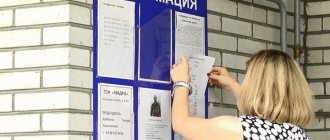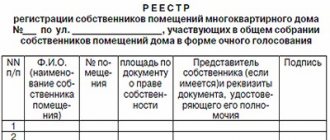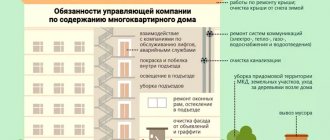Organization and agenda of the general meeting in an apartment building
The procedure for holding a house-wide meeting of residents is determined by clause 1 of Art. 45 Housing Code of the Russian Federation. This norm is mandatory in nature, which obliges owners to hold meetings of residents once a year. However, the legislative framework does not provide for a mechanism according to which participants undertake to organize such meetings annually.
Today, there are two fundamental forms of holding a general meeting: in person and in absentia. Regardless of the type of meeting, the success of a collective meeting depends on the ability of the initiative group not only to organize the meeting itself, but also to provide for possible voting outcomes.
Organizing a meeting of residents of an apartment building involves several main stages:
- Preparatory stage. At this point, the initiator of the meeting must determine the optimal place, time and date of the meeting. These parameters are selected taking into account the capabilities of the initiators and the interests of the majority of residents of the apartment building. As practice shows, collective meetings take place in the evening at the entrance or in the courtyard of the house.
- Next, the initiators of the meeting provide the material and technical base that is necessary to conduct voting and record the decisions of the owners. Cost estimates are carefully developed, which fall on the shoulders of all owners.
- If it is necessary to promote, i.e. lobby for a specific initiative during a general meeting, then the organizers must form a specific group of allies, develop campaign leaflets on which the agenda will be published, and also prepare speeches for some residents.
Thus, organizing a general meeting of an apartment building requires a lot of free time and effort.
Qualified majority of votes of the general meeting of owners
To ensure that the decisions put forward at the meeting of premises owners are lawful, there are certain mechanisms for counting votes. One of the main methods of decision-making is a qualified majority of votes. In this case, the decision will be considered legitimate if 2/3 or 3/4 of all homeowners take part in the vote.
Today, the legislation provides for certain issues, decisions on which can only be made by 2/3 or 3/4 votes (Article 44 of the RF Housing Code). These include:
- Reconstruction work for an apartment building.
- Determining the limits and boundaries of the use of the land plot on which the apartment building stands.
- Exploitation by owners or persons not related to real estate of the common property of an apartment building. In particular, the issue of installing advertising structures is being considered if the installation requires the use of common property.
- Agreement by the participants of the gathering of persons who can act on behalf of the owners, including entering into agreements aimed at the use of common property by other subjects of legal relations.
A more common decision-making mechanism at a meeting of property owners in an apartment building is a simple majority or quorum. In this case, to make a decision on the issues included in the agenda, it is enough to get 50% + 1 vote. A similar voting rule is provided for in Article 45 of the RF Housing Code.
However, it should be remembered that using this method to make decisions that are not included in the agenda is prohibited by law, namely, Art. 46 Housing Code of the Russian Federation. This norm is imperative in nature and therefore mandatory.
Signatures of owners in the minutes of the general meeting
Sometimes you can hear the opinion that all owners who took part in the meeting of owners must sign the final minutes of the general meeting of owners. It is not necessary. When holding an “in-person” meeting (i.e., through joint presence), the owners who arrived at the meeting are noted on the registration sheet (by putting their signature there) before voting begins. The presence of a quorum in this case is determined by the number of votes of the owners who left their autograph in the registration sheet. Further, the number of votes “for”, “against” and “abstained” on each issue can be determined by a “universal” count (by raising the hand of the voter) with the secretary of the meeting or the counting commission recording each vote in the appropriate voting sheet. However, in order to avoid inaccuracies or falsifications or banal mistrust of individual owners, it is advisable for each owner who took part in the vote or his representative by proxy to issue a voting sheet (ballot), in which the meeting participant will personally put down all the necessary data and sign it. Such registration of voting results will guarantee the fairness and transparency of the procedure and, if necessary, will allow checking the correctness of the calculation (recount the votes).
If the meeting is held in absentia, the voting sheets (ballots) of the owners will also be attached to the final minutes.
Thus, all owners of premises who took part in the voting do not need to sign the final protocol, except in cases provided for by law. So, for example, according to clause 1.1. Article 136 of the Housing Code of the Russian Federation, the minutes of the general meeting of owners of premises in an apartment building, at which decisions were made on the creation of a HOA and on the approval of its charter, are signed by all owners of premises in an apartment building who voted for the adoption of such decisions.
Minutes of the general meeting
The minutes of the decision of the general meeting of owners is considered a legal form of recording the voting results on the issues included in the agenda. 46 art. The Housing Code of the Russian Federation states that the minutes must be kept after the completion of the meeting in the place that was determined at the general meeting of the owners of residential premises.
The responsibility for maintaining the protocol may be assigned to one of the subjects of legal relations, whose candidacy is also adopted by a decision of a simple majority. Since the protocol is a document that has legal force, its execution plays a primary role in recognizing its legality.
A sample of such a document, which can be provided by all practicing lawyers, will help you avoid mistakes when drawing up a protocol. The sample minutes of the general meeting contains template information that is required to be filled out:
- date and address of the general meeting;
- the time and place where the vote counting process took place;
- the number of citizens present at the gathering (whether quorum was met);
- agenda;
- the results of the expression of will on each of the issues raised by the initiative group;
- Full name and signatures of the meeting chairman, secretary and members of the counting commission.
Preparation of the protocol
In accordance with Article 46 of the Housing Code, it is recommended to approve the procedure for drawing up the protocol at the beginning of the event.
The secretary and the presiding officer are responsible for maintaining and filling out the document.
The minutes are kept in writing; the final version must be ready no later than ten days after the event.
New requirements for document execution were approved by Order of the Ministry of Construction of the Russian Federation dated January 28, 2019 No. 44/pr.
Sample minutes of the general meeting of homeowners
Rules on the legal force of decisions of the general meeting of owners
The document of the house-wide meeting of the owners of the premises, which confirms the orders adopted at the meeting, will acquire legal force only if certain rules provided for by the norms of the Housing Code are observed:
- the decision was formalized through minutes, which were drawn up based on the results of a regular or extraordinary meeting;
- decisions on topical issues were made in strict accordance with the agenda;
- when the decision was made, the principle of quorum or qualified majority of votes was observed;
- the decision, which was made by the majority of owners, is officially communicated to all owners of apartments in an apartment building (This can be an open announcement of the results, as well as the distribution of official documents, which can be a certified copy of the protocol);
- decisions were made on issues that fall within the competence of the collective meeting.
The listed criteria may become the basis for citizens to go to court if they consider the decision to be unlawful.
Sample owner's decision (voting ballot)
Sample decision of the owner of the premises when holding a general meeting of owners in the apartment building in the form of absentee voting
Sample absentee voting ballot for a general meeting of owners in an apartment building (absentee voting ballot for a general meeting of owners on agenda items in an apartment building)
Sample ballot for voting at a general meeting of owners in the form of absentee voting (decision of the owner of the premises at the general meeting of owners of the premises of an apartment building, in the form of absentee voting)
Form of a written decision of the owner of the premises in an apartment building (to form a land plot on which the apartment building is located; to authorize the submission of an application for the formation of a land plot to the authorized executive body and to perform all necessary actions related to this...)
Rules for appealing a decision of the general meeting
After the decision of the joint meeting is adopted, the homeowner can appeal it in court. However, certain conditions must be met:
- During the general meeting, violations of current legislation were recorded.
- Only the owner who was either absent at the meeting or voted against the decision can appeal the decision. However, in this case the interests and rights of this citizen must be violated.
- An appeal against a decision can be made within a period not exceeding 6 months after the meeting.
To begin the appeal process, the owner must submit a written application to the court. In this case, it is necessary to provide comprehensive evidence of violations of voting or infringement of legitimate rights and interests.
Minutes form for the meeting of homeowners of apartment buildings
The collection and counting of signatures ends with the execution of a protocol. The current document template can be obtained from the local administration or you can use resources for downloading on the Internet. The main thing is that the paper complies with the provisions of the Order of the Ministry of Construction. Read the protocol form and download a well-written sample below.
Impossibility of holding a general meeting
The implementation of a collective meeting in practice becomes impossible if the initiators of the meeting were unable to assemble a quorum of residents (in the case of a simple majority) or achieve a quorum (if a qualified majority is required). In other words, even if the gathering takes place, it will be illegal, so the decisions made will not have legal force. It does not matter whether it is in-person or absentee voting.
If it is impossible to hold a meeting of residents, then the minutes of the general meeting are filled out in the manner prescribed by law. The document records the reason why the meeting did not take place at the scheduled time. The minutes of the general meeting are drawn up according to the established template and signed by authorized persons.






